Round The World and other travels
A frequent flyer's collection of trip diaries
This is: Voyage of the Glaciers (2015)
In Dublin's fair city


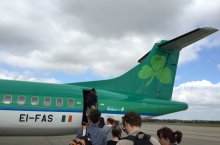 I was sitting in the Mochaland Café, an
independent coffee shop and bistro on the north bank of the River Liffey.
It was around 2:30 in the afternoon and I was having an
uncharacteristically late lunch. It seemed like a good moment to take stock:
at this midpoint in the day, a good deal had already been accomplished and
yet much remained outstanding on my agenda. After an early rise, I had made my
way to Edinburgh Airport and flown the short hop across to the Irish
capital - the first small stage in a purposefully indirect
journey designed to deliver me in due course to the state capital of
Montana. After transferring to Dublin city centre and getting wet
courtesy of a badly timed shower, I had installed myself in the
building just across the side street from where I was sitting - a
well located and thoroughly impressive boutique hotel called The
Morrison that was now being marketed by the Hilton group. As I
worked on satisfying my hunger, I glanced out at the busy Lower
Ormond Quay to observe a constant stream of traffic doing its best to keep moving.
Another heavy shower had started and people attempting to view the
sights on a steady procession of open-top tour buses were not
looking overly amused, as they resigned themselves to another summertime
soaking.
I was sitting in the Mochaland Café, an
independent coffee shop and bistro on the north bank of the River Liffey.
It was around 2:30 in the afternoon and I was having an
uncharacteristically late lunch. It seemed like a good moment to take stock:
at this midpoint in the day, a good deal had already been accomplished and
yet much remained outstanding on my agenda. After an early rise, I had made my
way to Edinburgh Airport and flown the short hop across to the Irish
capital - the first small stage in a purposefully indirect
journey designed to deliver me in due course to the state capital of
Montana. After transferring to Dublin city centre and getting wet
courtesy of a badly timed shower, I had installed myself in the
building just across the side street from where I was sitting - a
well located and thoroughly impressive boutique hotel called The
Morrison that was now being marketed by the Hilton group. As I
worked on satisfying my hunger, I glanced out at the busy Lower
Ormond Quay to observe a constant stream of traffic doing its best to keep moving.
Another heavy shower had started and people attempting to view the
sights on a steady procession of open-top tour buses were not
looking overly amused, as they resigned themselves to another summertime
soaking.
 |
 |
 |
| LEFT to RIGHT: Only in Ireland, crossing the Liffey and passing City Hall | ||
When this latest burst of rain had run its course, I decided that I had better seize the opportunity and get going; after all, it was already past three o'clock. I crossed the river on Grattan Bridge and walked the short distance via City Hall and Dublin Castle to Christ Church Cathedral.
Christ Church, also known as the Cathedral of the Holy Trinity, dates from the 11th century and is the older of Dublin's two Anglican cathedrals. Although it has been the seat of the Church of Ireland's Archbishop of Dublin since the 16th century, Christ Church - through a quirk of history - is still theoretically proclaimed by the Roman Catholic Church to be Dublin's pre-eminent cathedral. This is because a papal decree to this effect was issued in the 12th century to clarify the role of Christ Church in relation to nearby St Patrick's, and the edict has never been formally revoked. For this reason, the present-day seat of the RC Archbishop of Dublin, situated on the other side of the river, is designated a 'pro-cathedral'. I couldn't work out whether the unusual standing of Christ Church introduced a delightful blurring of distinctions into Ireland's often sharply divided religious landscape, or whether it might in fact be an illustration of that very division.
One thing that was crystal-clear was the popularity of the cathedral as a tourist objective, so although I had visited briefly in the past, I decided to have a more thorough look around now. The part of the cathedral complex across the bridge from the church itself has since the 1990s been used to accommodate the Dublinia museum, showcasing the city's Viking and medieval past.
 |
 |
 |
 |
 |
 |
 |
 |
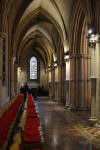 |
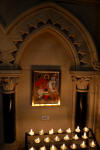 |
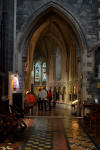 |
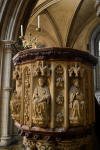 |
 |
Next, I took a short walk southwards - it took less than ten minutes - to Dublin's other great medieval cathedral, St Patrick's. The city is highly unusual and possibly even unique in the western world, in having two pre-Reformation churches with the rank of cathedral, one of which (St Patrick's) has never been the seat of a bishop. An agreement was drawn up as long ago as 1300, sharing diocesan functions between Christ Church and St Patrick's, and this survived through the Reformation up to disestablishment of the Church of Ireland in 1870. The newly independent church promptly settled the issue once and for all: Christ Church was confirmed as the sole diocesan cathedral and St Patrick's was given a new role as a 'national cathedral' for the whole of Ireland. Interestingly, St Patrick's has two 'ecumenical canons', one Presbyterian and one RC.
This was my first visit to the national cathedral, although I remembered passing through the adjacent St Patrick's Park on a previous visit to the city. I was offered the chance to join a guided tour, but decided that I would be happier looking around at my own pace.
 |
 |
 |
 |
 |
 |
 |
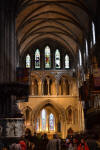 |
 |
 |
 |
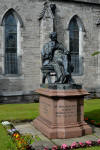 |
At one point during my wanderings I was engaged in conversation by a gentleman who was connected with the cathedral. We ended up chatting for a good twenty minutes, covering topics such as the existence of the two historic cathedrals (his take on the matter was that the situation had been brought about by the machinations of the English ruling class of the time); contemporary churchmanship in the Church of Ireland (more 'low church' than most parts of the Anglican Communion, with visiting bishops frequently attracting disapproving comments for their allegedly over-elaborate dress); relations with the Roman Catholic Church (never been better); the so-called 'troubles' in Northern Ireland (depressingly, he reckoned that underlying attitudes in many people had barely changed); and finally, Edinburgh, which he obviously held in great affection and about which he seemed to know a great deal. All in all, an interesting, enjoyable and above all friendly chat!
| RIGHT: Heading through St Stephen's Green and towards Trinity College |
 |
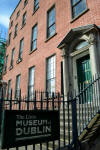 |
 |
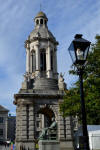 After that, I re-emerged into the open air and continued my walk in
what was now bright and warm sunshine, through the familiar
territory of St Stephen's Green and Dawson Street towards Trinity
College. I have long since been of the view that Trinity College is
probably the most attractive spot in the whole of Dublin, forming
this opinion before I had even visited the city, when it was used as
the setting for the university shots in the 1983 movie Educating
Rita.
After that, I re-emerged into the open air and continued my walk in
what was now bright and warm sunshine, through the familiar
territory of St Stephen's Green and Dawson Street towards Trinity
College. I have long since been of the view that Trinity College is
probably the most attractive spot in the whole of Dublin, forming
this opinion before I had even visited the city, when it was used as
the setting for the university shots in the 1983 movie Educating
Rita.
 |
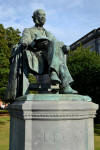 |
 |
 |
 |
 |
 |
 |
 |
 |
| RIGHT: O'Connell Bridge and Ha'penny Bridge |
 |
 |
 |
Following all that, and despite enjoying a seat in the sun for a while at Trinity College, I felt a little tired and realised that it was time to make my way back to The Morrison via the riverbank. In due course I had drinks and dinner at the hotel's Quay 14 bar, which also served food from the adjacent Morrison Grill restaurant. After a Hendrick's Martini to set the scene, I enjoyed an insanely delicious Cream of Celeriac soup and a duck breast main course with a glass of red wine - a fabulous ending to a fairly long and busy first day!